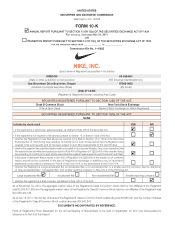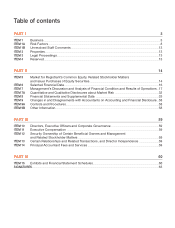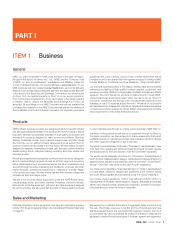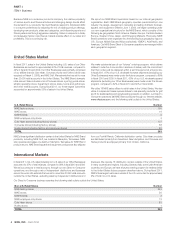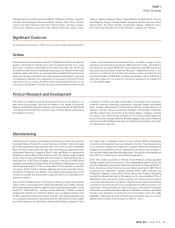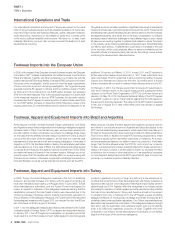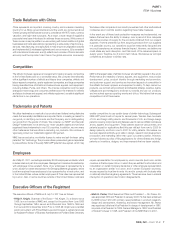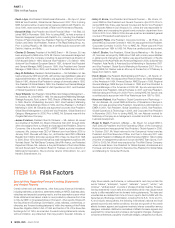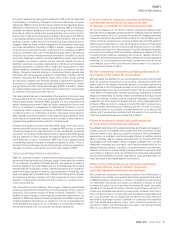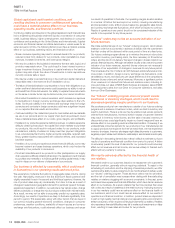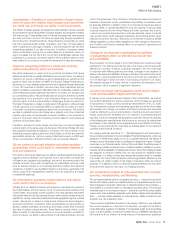Nike 2011 Annual Report Download - page 9
Download and view the complete annual report
Please find page 9 of the 2011 Nike annual report below. You can navigate through the pages in the report by either clicking on the pages listed below, or by using the keyword search tool below to find specific information within the annual report.9NIKE,INC.-Form10-K
PARTI
ITEM1ARisk Factors
and sports; seasonal and geographic demand for NIKE products; diffi culties
in anticipating or forecasting changes in consumer preferences, consumer
demand for NIKE products, and the various market factors described above;
diffi culties in implementing, operating, and maintaining NIKE’s increasingly
complex information systems and controls, including, without limitation,
the systems related to demand and supply planning, and inventory control;
interruptions in data and communications systems; fl uctuations and diffi culty
in forecasting operating results, including, without limitation, the fact that
advance “futures” orders may not be indicative of future revenues due to
changes in shipment timing, and the changing mix of futures and at-once orders
and order cancellations; the ability of NIKE to sustain, manage or forecast
its growth and inventories; the size, timing and mix of purchases of NIKE’s
products; increases in the cost of materials and energy used to manufacture
products, new product development and introduction; the ability to secure
and protect trademarks, patents, and other intellectual property; performance
and reliability of products; customer service; adverse publicity; the loss of
signifi cant customers or suppliers; dependence on distributors and licensees;
business disruptions; increased costs of freight and transportation to meet
delivery deadlines; increases in borrowing costs due to any decline in our debt
ratings; changes in business strategy or development plans; general risks
associated with doing business outside the UnitedStates, including, without
limitation, exchange rate fl uctuations, import duties, tariffs, quotas, political
and economic instability, and terrorism; changes in government regulations;
the impact of, including business and legal developments relating to, climate
change; liability and other claims asserted against NIKE; the ability to attract
and retain qualifi ed personnel; and other factors referenced or incorporated
by reference in this report and other reports.
The risks included here are not exhaustive. Other sections of this report may
include additional factors which could adversely affect NIKE’s business and
fi nancial performance. Moreover, NIKE operates in a very competitive and
rapidly changing environment. New risk factors emerge from time to time
and it is not possible for management to predict all such risk factors, nor can
it assess the impact of all such risk factors on NIKE’s business or the extent
to which any factor, or combination of factors, may cause actual results to
differ materially from those contained in any forward-looking statements. Given
these risks and uncertainties, investors should not place undue reliance on
forward-looking statements as a prediction of actual results.
Investors should also be aware that while NIKE does, from time to time,
communicate with securities analysts, it is against NIKE’s policy to disclose
to them any material non-public information or other confi dential commercial
information. Accordingly, shareholders should not assume that NIKE agrees
with any statement or report issued by any analyst irrespective of the content
of the statement or report. Furthermore, NIKE has a policy against issuing
or confi rming fi nancial forecasts or projections issued by others. Thus, to
the extent that reports issued by securities analysts contain any projections,
forecasts or opinions, such reports are not the responsibility of NIKE.
Our products face intense competition.
NIKE is a consumer products company and the relative popularity of various
sports and fi tness activities and changing design trends affect the demand
for our products. The athletic footwear, apparel, and equipment industry is
keenly competitive in the UnitedStates and on a worldwide basis. We compete
internationally with a signifi cant number of athletic and leisure shoe companies,
athletic and leisure apparel companies, sports equipment companies, and
large companies having diversifi ed lines of athletic and leisure shoes, apparel,
and equipment. We also compete with other companies for the production
capacity of independent manufacturers that produce our products and for
import quota capacity.
Our competitors’ product offerings, technologies, marketing expenditures
(including expenditures for advertising and endorsements), pricing, costs of
production, and customer service are areas of intense competition. This, in
addition to rapid changes in technology and consumer preferences in the
markets for athletic and leisure footwear and apparel, and athletic equipment,
constitute signifi cant risk factors in our operations. If we do not adequately and
timely anticipate and respond to our competitors, our costs may increase or
the consumer demand for our products may decline signifi cantly.
If we are unable to anticipate consumer preferences
anddevelop new products, we may not be able
tomaintain or increase our net revenues and profi ts.
Our success depends on our ability to identify, originate and defi ne product
trends as well as to anticipate, gauge and react to changing consumer demands
in a timely manner. All of our products are subject to changing consumer
preferences that cannot be predicted with certainty. Our new products may not
receive consumer acceptance as consumer preferences could shift rapidly to
different types of performance or other sports apparel or away from these types
of products altogether, and our future success depends in part on our ability
to anticipate and respond to these changes. If we fail to anticipate accurately
and respond to trends and shifts in consumer preferences by adjusting the mix
of existing product offerings, developing new products, designs, styles and
categories, and infl uencing sports and fi tness preferences through aggressive
marketing, we could experience lower sales, excess inventories and lower
profi t margins, any of which could have an adverse effect on our results of
operations and fi nancial condition.
We rely on technical innovation and high quality products
to compete in the market for our products.
Although design and aesthetics of our products appear to be the most important
factor for consumer acceptance of our products, technical innovation and
quality control in the design of footwear, apparel, and athletic equipment is
also essential to the commercial success of our products. Research and
development plays a key role in technical innovation. We rely upon specialists
in the fi elds of biomechanics, exercise physiology, engineering, industrial
design and related fi elds, as well as research committees and advisory boards
made up of athletes, coaches, trainers, equipment managers, orthopedists,
podiatrists, and other experts to develop and test cutting edge performance
products. While we strive to produce products that help to reduce injury,
enhance athletic performance and maximize comfort, if we fail to introduce
technical innovation in our products consumer demand for our products could
decline, and if we experience problems with the quality of our products, we
may incur substantial expense to remedy the problems.
Failure to continue to obtain high quality endorsers
ofourproducts could harm our business.
We establish relationships with professional athletes, sports teams and leagues to
evaluate, promote, and establish product authenticity with consumers. Ifcertain
endorsers were to stop using our products contrary to their endorsement
agreements, our business could be adversely affected. In addition, actions
taken by athletes, teams or leagues associated with our products that harm
the reputations of those athletes, teams or leagues could also harm our brand
image with consumers and, as a result, could have an adverse effect on our
sales and fi nancial condition. In addition, poor performance by our endorsers,
a failure to continue to correctly identify promising athletes to use and endorse
our products, or a failure to enter into cost effective endorsement arrangements
with prominent athletes and sports organizations could adversely affect our
brand and result in decreased sales of our products.
Failure of our contractors or our licensees’ contractors
tocomply with our code of conduct, local laws,
andotherstandards could harm our business.
We contract with hundreds of contractors outside of the UnitedStates to
manufacture our products, and we also have license agreements that permit
unaffi liated parties to manufacture or contract to manufacture products using
our trademarks. We impose, and require our licensees to impose, on those
contractors a code of conduct and other environmental, health, and safety
standards for the benefi t of workers. We also require these contractors to
comply with applicable standards for product safety. However, from time to
time contractors may not comply with such standards or applicable local
law or our licensees may not require their contractors to comply with such
standards or applicable local law. Signifi cant or continuing noncompliance
with such standards and laws by one or more contractors could harm our
reputation or result in a product recall and, as a result, could have an adverse
effect on our sales and fi nancial condition.

